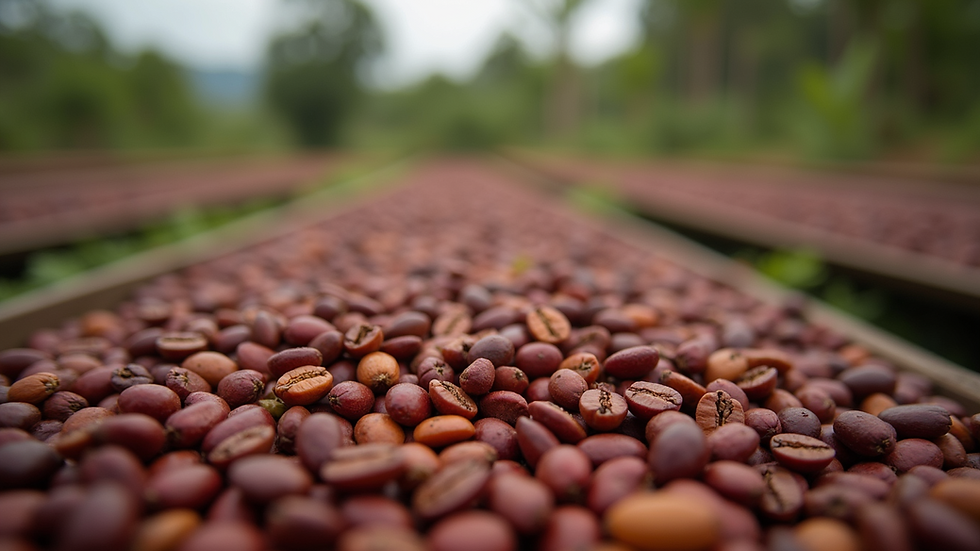The Origin of Arabica Coffee
- semretek5
- Sep 22
- 4 min read
Ethiopia is frequently referred to as the birthplace of coffee, and justifiably so. The nation's varied landscapes and distinct climate offer ideal conditions for cultivating some of the world's finest coffee beans. As a coffee entrepreneur discovering new coffee flavors, I find Ethiopian coffee varieties endlessly intriguing. Each type narrates a tale of tradition, culture, and nature merging in a cup. To experience coffee in its most genuine and lively form, exploring Ethiopian coffee is a journey well worth embarking on.
Exploring the Unique Ethiopian Coffee Types
When you talk about Ethiopian coffee types, you’re stepping into a world of variety and complexity. Ethiopia’s coffee-growing regions are scattered across highlands, valleys, and plateaus, each producing beans with distinct characteristics. The main types you’ll encounter include Sidamo, Yirgacheffe, Harrar, and Limu. Each has its own flavor profile, aroma, and body, shaped by the soil, altitude, and traditional farming methods.
Sidamo coffee is known for its bright acidity and floral notes. It often carries hints of citrus and berries, making it a refreshing choice for those who enjoy a lively cup.
Yirgacheffe is famous for its clean, crisp taste with a tea-like body. It often features fruity and floral flavors, such as Strawberry, blackberry, lemon, jasmine, and bergamot.
Harrar coffee stands out with its bold, wine-like taste and heavy body. It’s a favorite for those who appreciate a rich, intense brew with complex fruity undertones of blueberry and chocolate/mocha.
Limu offers a balanced cup with a mild acidity and sweet, fruity flavors. It’s smooth and approachable, perfect for everyday enjoyment.
These types are just the beginning. Within each region, farmers cultivate different heirloom varieties, each adding layers of nuance to the coffee’s character.

What Type of Coffee Is Grown in Ethiopia?
Ethiopia primarily grows Arabica coffee, which is prized worldwide for its superior flavor and aroma. Unlike Robusta, Arabica beans tend to have a sweeter, softer taste with hints of fruit and sugar. Ethiopia’s Arabica coffee is often grown in small, family-owned farms using organic and traditional methods. This not only preserves the environment but also enhances the quality of the beans.
The country’s coffee plants are mostly heirloom varieties, meaning they have been passed down through generations without hybridization. This genetic diversity contributes to the wide range of flavors found in Ethiopian coffee. The beans are typically handpicked at peak ripeness, ensuring the best possible quality.
Ethiopian coffee is often processed using the washed (wet) or natural (dry) methods. The washed method involves removing the coffee cherry’s outer layers before drying, resulting in a cleaner, brighter cup. The natural method dries the whole cherry, imparting fruity and wine-like flavors to the beans. Both methods highlight different aspects of the coffee’s character, giving you options depending on your taste preferences.

The Cultural Significance of Ethiopian Coffee
Coffee in Ethiopia is more than just a drink - it’s a cultural ritual that brings people together. The traditional Ethiopian coffee ceremony is a beautiful, slow process that involves roasting green coffee beans over an open flame, grinding them by hand, and brewing the coffee in a special pot called a jebena. This ceremony is a symbol of hospitality and respect, often lasting for hours as friends and family gather to share stories and enjoy the rich flavors.
Understanding this cultural context adds depth to the experience of drinking Ethiopian coffee. When you sip a cup of Harrar or Yirgacheffe, you’re tasting centuries of tradition and care. This connection to the land and people is part of what makes Ethiopian coffee so special.
How to Choose and Brew Ethiopian Coffee at Home
If you want to bring the magic of Ethiopian coffee into your kitchen, here are some tips to get started:
Choose your coffee type: Decide whether you prefer a bright, floral coffee like Yirgacheffe or a bold, fruity one like Harrar. Look for beans that are freshly roasted and ethically sourced.
Grind fresh: For the best flavor, grind your beans just before brewing. Use a burr grinder for a consistent grind size.
Use the right water temperature: Aim for water between 195°F and 205°F. Too hot or too cold can affect the taste.
Try different brewing methods: Pour-over, French press, and Aeropress all work well with Ethiopian coffee. Each method brings out different flavor notes.
Experiment with ratios: Start with about 1 to 2 tablespoons of coffee per 6 ounces of water and adjust to your taste.
By paying attention to these details, you can enjoy the full spectrum of flavors that Ethiopian coffee types have to offer.

Why Ethical Sourcing Matters for Ethiopian Coffee
One of the reasons I’m passionate about Ethiopian coffee is the emphasis on ethical sourcing. Many Ethiopian coffee farmers are smallholders who rely on coffee as their main source of income. Supporting fair trade and direct trade initiatives helps ensure these farmers receive fair compensation for their hard work.
Ethically sourced coffee also means better quality. When farmers are paid fairly, they can invest in sustainable farming practices and maintain the health of their coffee plants. This leads to beans that are not only delicious but also grown with respect for the environment.
If you want to explore authentic Ethiopian coffee, I recommend checking out ethiopian coffee varieties. They specialize in premium, ethically sourced beans, including their signature Harrar coffee, which truly captures the spirit of Ethiopia’s coffee heritage.
Embracing the Ethiopian Coffee Experience
Exploring Ethiopian coffee types is more than just tasting different beans - it’s about connecting with a rich history and culture. Each cup offers a glimpse into the land where coffee was born, with flavors that are vibrant, complex, and deeply satisfying.
Whether you're brewing a vibrant Sidamo in the morning or enjoying a rich Harrar in the afternoon, Ethiopian coffee encourages you to take a moment to appreciate the craft of coffee. It's an exploration that I'm thrilled to share with you, one cup at a time.






Comments